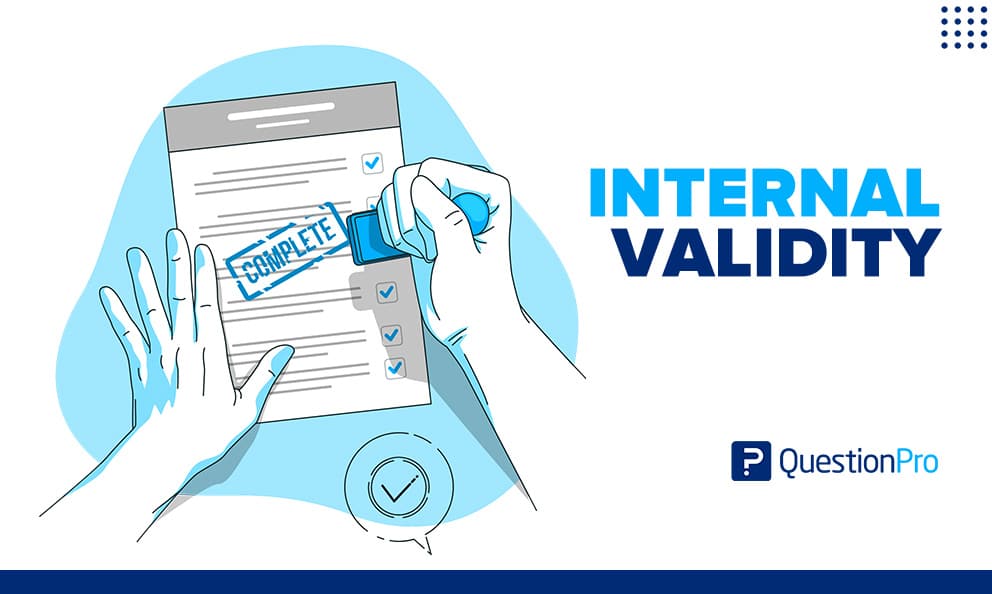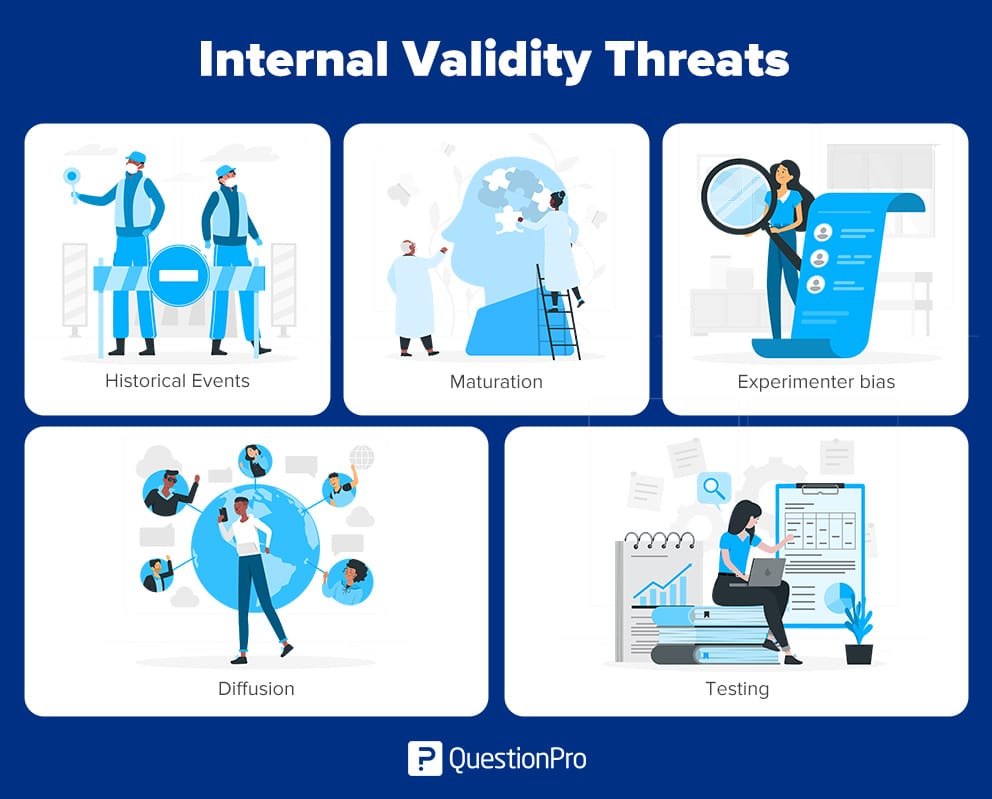
Internal validity refers to how confident you are in your research findings. It is one of the most essential aspects of scientific research and a key idea in understanding facts in general. You can only determine the accuracy of your research as a researcher if no factors contradict your findings. It is the extent of confidence in the outcome. This post will examine internal validity, why it’s important, its examples, and more.
LEARN ABOUT: Causal Research
What is internal validity?
Internal validity in research verifies cause-and-effect relationships between your test situation and your research outcome. It also refers to the ability of research to rule out other causes for a result.
Confounding is a condition in which various factors interfere with the outcome of a research. The lower the chance of confounding in a study, the higher its internal validity. And from this, we can be more confident in the outcome.
In other words, if you can rule out other possible causes for your findings, you can be sure that your research is internally valid. If your study meets the following three requirements, then you can only presume cause and effect:
- The cause and effect change simultaneously.
- In terms of time, the cause comes before the effect.
- There are no other plausible reasons for the correlation you’ve found.
Internal validity further reveals that having the standard data helps a researcher to exclude irrelevant outcomes from the study. If the sample groups are correctly selected and measured, the relationship between the data will be acceptable.
The importance of internal validity
Researchers frequently attempt to establish clear relationships between the variables when they conduct experiments. Internal validity permits them to trust and believe the conclusions of a study’s causal relationship.
When an experiment’s external validity is low, it cannot confidently demonstrate a causal relationship between the variables under consideration. That’s why it matters in research. This can be one of the most powerful research tools if applied correctly.
Establishing causal relationships
It lets researchers come to correct conclusions about how one variable leads to another. Researchers can be sure that changes in the independent variable cause changes in the dependent variable if they design studies with good internal validity.
Reducing confounding factors
It helps control for and reduce the effect of confusing variables, which are outside factors that could affect the results. By carefully planning experiments, using control groups, and assigning things at random, researchers can isolate the effects of the independent variable and be more sure of the link between the two.
Ensuring measurement accuracy
This makes sure that the tools used to measure things in a study are accurate and reliable. By using valid and reliable measures, researchers can correctly measure the variables of interest and reduce measurement error, increasing the study’s internal validity.
Enhancing replicability
Replication is an important part of scientific study because it makes it more likely that the results can be used in other situations. Researchers are more likely to repeat studies that have a lot of internal validity. When it is a top priority, other researchers can use the research design and methods to get similar results, which adds to the scientific knowledge base.
Generalizability to real-world settings
It is a part of external validity, which is the ability of study results to be used in real-world settings and with real-world populations. By addressing concerns about it, researchers can make it more likely that their findings properly reflect what would happen in real life. This makes it easier for research results to be used in real life.
Influencing decision-making and policy development
Studies with high internal validity have a greater impact on decision-making processes and policy development. Policymakers rely on rigorous and internally valid research to make informed decisions and implement effective policies. Strong internal validity increases the credibility and trustworthiness of research findings, leading to greater influence in decision-making processes.
Internal validity threats
Internal validity threats need to be identified in a research project. This will help researchers in creating appropriate controls in research. There are numerous techniques to ensure that a study is internally valid. Still, there is also a list of potential risks to it that need to be considered while designing a survey.
Consider the following typical threats:

Historical events
Historical events have an impact on the outcomes of research conducted during a given time period. This is because many events might influence how people feel or respond to a particular subject. For example, changes in political leadership or natural disasters can have an impact on how survey respondents think and behave.
Maturation
Experiments that are performed over a lengthy moment are most vulnerable to maturation. The effect of time as a variable in research is explained in this way. It may be challenging to prove that the results of your study were not affected by time if your subjects grew older or went through a biological change.
Experimenter bias
This happens when the experimenter behaves differently in one group than in another. This can be for or against the group. The researcher’s bias may have an impact on the study’s findings. If an experimenter behaves differently in different study groups, it may have an effect on the results and reduce the study’s internal validity.
Diffusion
This happens when experiment participants interact and observe one another, compromising the study’s findings’ reliability. Resentful demoralization is an issue that might arise as a result of this. Control group members work less complicated because they feel resentful of their group.
Testing
Experiments can require testing the same subjects multiple times in order to collect more accurate information. Testing participants with the same measurements on a regular basis has an impact on their results. Participants are likely to do better as they learn the test or become more familiar with the testing process; therefore, repeated testing could significantly impact outcomes.
Internal validity examples
Internal validity can be seen in the following examples:
Example 1
It is lower in an inquiry that examines the link between income level and the risk of smoking. According to a study, there is a correlation between smoking and being a low-income person.
Occupation, culture, education, social standing, and other variables are examples of different sorts of factors. Such factors cannot be eliminated from the research. It is a concept that aids in establishing that you have evidence that your findings significantly impact the outcomes.
Example 2
An investigator performs research to examine the effect of specially designed computer applications for teaching on traditional classroom techniques. According to the study’s findings, children who are taught using computer software learn faster.
Another research finding is that computerized teaching has significantly improved children’s grade levels. Other researchers’ research suggests that youngsters taught using computer software believe they are not being paid attention to.
Because research data manipulation has an impact, an experiment still has excellent internal validity. The construct validity of the study report studies is low because the cause is not defined clearly. The researcher prioritizes attention over the benefits of computer programs.
Example 3
It requires correlation, which occurs when the two events coincide. For example, the egg must directly result from the chicken’s biological abilities. The study must also be non-spurious, which indicates that no other believable possibility exists, such as an angel continuously impregnating all hens on the globe.
Example 4
Another example of it is time priority or proving that the cause occurred before the consequence. One could argue that smoking cigarettes cause lung cancer by demonstrating that most of those treated had a smoking history.
What is internal validity vs. external validity?
Both internal and external validity have different meanings. While internal validity means the extent to which the results are reliable and external validity means the extent to which they are applicable to a different situation. It’s also crucial to consider their importance in the building and analyzing of your own research.
It counts as it ensures that the variable you change actually affects your measurement outcome. External validation is important because the changes measured are more universal.
| Comparison | Internal Validity | External Validity |
| Meaning | Internal validity refers to how error-free the experiment is and how any measurement discrepancy is solely attributable to the independent variable. | External validity refers to how much the research results can be extrapolated to the rest of the world. |
| Concerns | Controlled | Naturalness |
| What is it? | It is a way to figure out how well the experiment worked. | It sees if the causal connection found in the experiment can be used in other situations. |
| Identifies | How effective the research methods are. | Can the research’s results be put to use in the real world? |
| Describes | How much is the conclusion supported by the evidence? | The extent to which it is justified to generalize the research’s findings to other contexts. |
| Used to | Address or get rid of other possible reasons for the result. | Generalize the result. |
Conclusion
An experiment cannot demonstrate a causal link between two variables without strong internal validity. It ensures that the experiment design selected by the researcher complies with the concept of cause and effect. It lends credibility and trustworthiness to the conclusions of a causal link.
It is a very important part of research design. It refers to how well a study shows a cause-and-effect link between variables. It makes sure that the effects seen can be linked to the independent variable and not to other factors that could be confusing.
Maintaining a high level of it makes research results more credible and reliable. This lets researchers come to accurate conclusions and make important contributions to the field. Researchers can use rigorous methods and control measures to improve it and reduce threats, such as selection bias, confounding factors, and measurement errors.
It’s important to remember that internal validity alone doesn’t guarantee external validity or that the results can be used in the real world. Other measures of validity should be used along with this to judge the total quality of the research.
At QuestionPro, we provide researchers with data-gathering tools such as our survey software and an insights library for long-term study of all types. If you’d like to see a demo or learn more about it, please go to the Insight Hub.
Frequently asked questions(FAQ)
Internal validity is a way to measure the quality of the research.
Internal validity is very important because it ensures that the effects seen in the research are caused by the independent variable and not by something else. It lets experts come to accurate conclusions about the links between causes and effects.
Blinding, which is also called “masking,” is a way to keep subjects or researchers from knowing who is in which group or what the conditions are. It helps reduce biases that can happen because of assumptions or ideas you already have, which improves internal validity.
Internal validity is often threatened by things like participant dropout or attrition, history effects, maturation, testing effects, instrumentation effects, return to the mean, and selection bias.







